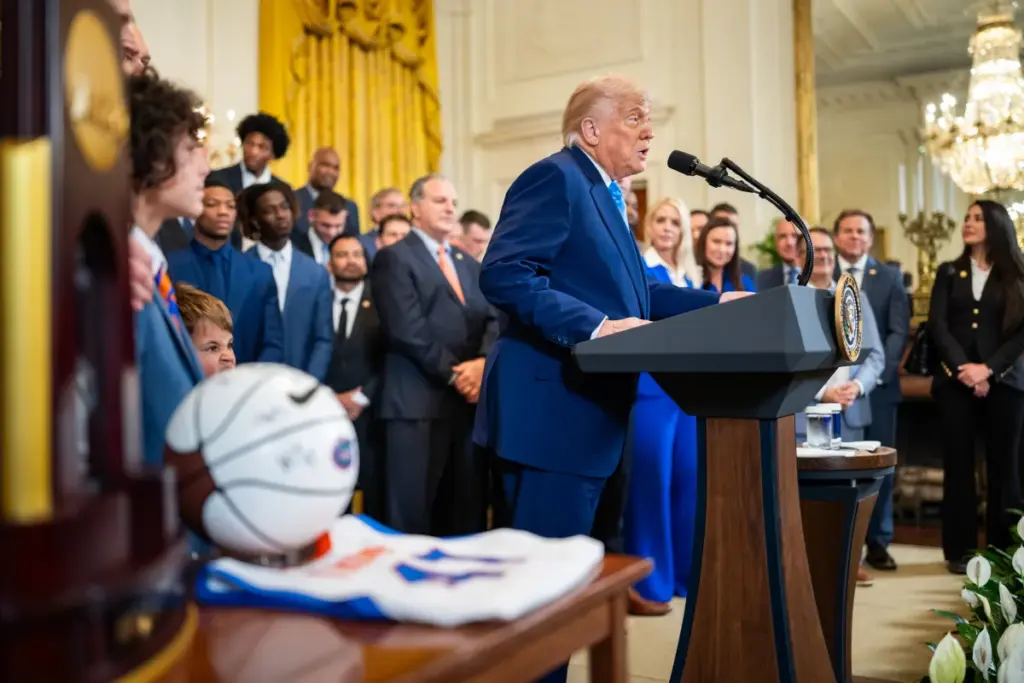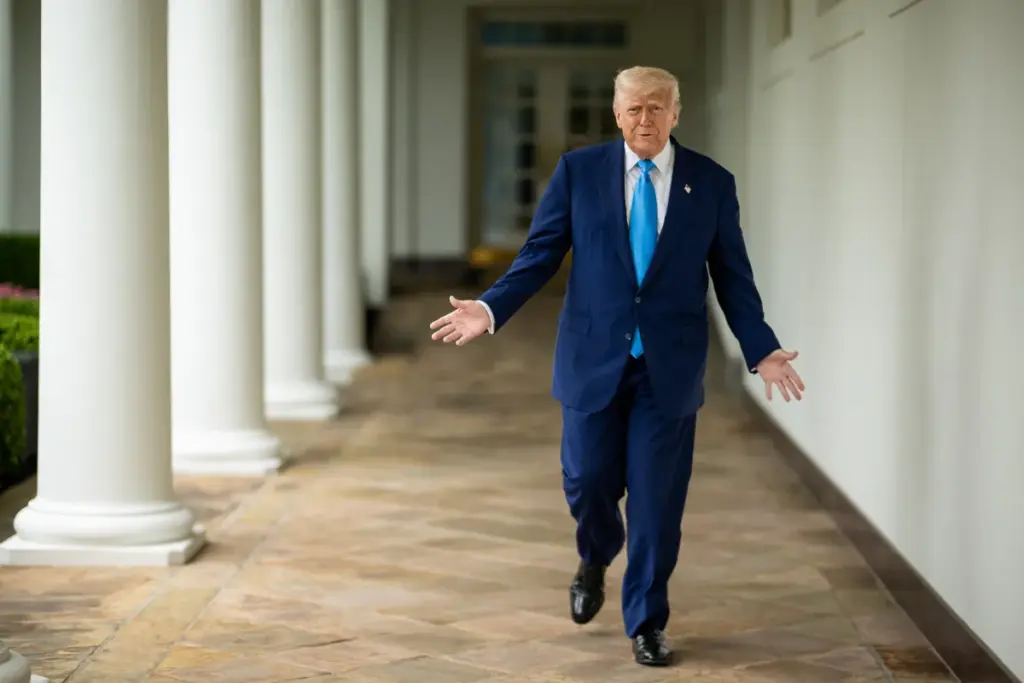President Donald Trump has signed a groundbreaking executive order that seeks to clarify the employment status of NCAA athletes, shaking the foundation of college sports. This directive, announced today, aims to preserve athletic scholarships and curb third-party pay-for-play schemes, as detailed by ESPN.
The order introduces new financial guidelines that will reshape the economics of collegiate athletics, impacting schools, players, and fans alike. This article delves into the financial implications for each group, analyzes how it will transform college football, and evaluates the broader consequences, offering a detailed perspective on this pivotal moment in sports history.

🔍 Context and Background
The executive order, signed on July 24, 2025, directs Trump’s Cabinet, including Secretary of Education Linda McMahon, to develop a plan within 30 days to protect college sports opportunities while preventing athletes from being classified as professionals. This move responds to a decade-long erosion of the NCAA’s amateurism model, driven by legal challenges and state laws, as noted in the ESPN report.
The order mandates that schools maintain or increase scholarships based on revenue thresholds—$50 million and $125 million annually—while banning third-party pay-for-play payments, though it allows fair-market-value endorsement deals.
Historically, the NCAA prohibited athlete compensation, but recent antitrust settlements, including a $2.8 billion agreement approved in June 2025, now permit schools to pay athletes up to $20.5 million per year, labeled as endorsements.
This shift has sparked debates about employment status, with the National Labor Relations Board (NLRB) previously considering athlete unionization. Trump’s intervention aims to stabilize this evolving landscape, though it lacks the authority to grant an antitrust exemption, a move that requires congressional action, as highlighted by NCAA President Charlie Baker’s statement.
The order’s timing coincides with the launch of the College Sports Commission by the Power Four conferences, tasked with vetting third-party deals. However, critics like attorney Steve Berman, involved in the antitrust settlement, argue that Trump’s policy restricts athletes’ newfound freedoms.
💰 Financial Impact on Schools
The executive order introduces significant financial considerations for colleges, particularly those in the Power Four conferences (SEC, Big Ten, Big 12, ACC), which dominate revenue generation.
Budgetary Pressures and Scholarship Mandates
Schools earning over $125 million annually—approximately 30–40 institutions, including powerhouses like Alabama and Ohio State—must increase scholarships for non-revenue sports, such as women’s soccer or track. This mandate, effective immediately, could cost these schools an additional $1–$2 million per year, depending on roster sizes and scholarship values (typically $20,000–$50,000 per athlete). Institutions in the $50–$125 million range, including most Power Four members, cannot reduce existing scholarships, locking in current spending levels.
For mid-major schools below the $50 million threshold, the financial burden may be lighter, but they risk falling further behind in competitiveness. The ESPN report notes that many high-revenue schools have already pledged to expand scholarships, suggesting a $10–$15 million collective investment across the top tier in 2025–26. However, smaller programs may struggle to comply, potentially cutting teams or staff, which could lead to a 5–10% budget reduction in athletic departments.

Revenue Redistribution and Third-Party Restrictions
The ban on third-party pay-for-play payments disrupts a lucrative revenue stream for wealthy schools. Boosters and collectives, which funneled $50–$100 million annually into athlete payments via name, image, and likeness (NIL) deals, will face stricter oversight from the College Sports Commission.
This could reduce discretionary spending by 20–30%, forcing schools to reallocate funds from marketing or facilities to meet scholarship requirements.
Conversely, the order’s allowance for fair-market-value endorsements offers a lifeline, potentially generating $5–$10 million per year for top programs through legitimate partnerships.
However, enforcing this distinction will require robust auditing, estimated to cost schools $500,000–$1 million annually in compliance efforts. The financial tightrope will challenge athletic directors to balance compliance with competitiveness, especially as revenue disparities widen.
Long-Term Economic Implications
Over the next decade, schools may face a $50–$100 million cumulative cost to align with the order, per industry projections. High-revenue programs could absorb this through ticket sales and TV deals, which exceed $200 million annually for the Big Ten and SEC.
Mid-majors risk insolvency, with some estimating a 15–20% chance of program cuts by 2030. Therefore, the order could accelerate consolidation, favoring elite schools while straining the NCAA’s broad membership.
💸 Financial Impact on Players
The executive order’s restrictions and clarifications will directly affect athletes’ financial prospects, reshaping their earning potential and security.
Loss of Third-Party Income
Players, particularly in football and basketball, have relied on third-party NIL deals—often exceeding $1 million per year for stars like Arch Manning—to supplement scholarships. The ban on pay-for-play arrangements could slash this income by 50–70%, reducing annual earnings for top athletes to $200,000–$500,000 through fair-market endorsements.
For mid-tier players, payments might drop from $50,000 to $10,000–$20,000, limiting their financial independence. This shift disadvantages athletes at wealthier schools, where booster collectives previously offset costs like training or education.
The ESPN report highlights attorney Steve Berman’s concern that Trump’s order hampers athletes’ deal-making autonomy, potentially violating their economic rights. However, the order preserves scholarship funding, ensuring $15,000–$30,000 per year for most players, a critical safety net.

Scholarship Stability and Educational Focus
The mandate to maintain or increase scholarships benefits athletes in non-revenue sports, who often receive partial or no aid. For example, a women’s volleyball player might see her scholarship rise from $5,000 to $20,000, adding $15 million collectively across NCAA Division I. This stability supports educational goals, aligning with the order’s intent to maximize “educational benefits,” as stated by Trump.
Yet, this comes at a cost. Players in revenue sports may feel sidelined, as funds shift to less profitable teams. The lack of a salary cap or unionization option, if the NLRB rules against employee status, could leave athletes without bargaining power, potentially reducing their long-term earnings by $5–$10 million over a career, per labor estimates.
Future Financial Uncertainty
The order’s ambiguity on employment status creates uncertainty. If the NLRB declares athletes non-employees, they cannot unionize, locking them out of collective bargaining for benefits like health insurance or retirement plans, valued at $50,000–$100,000 over a career.
Conversely, an employee ruling could mandate minimum wages ($15/hour, or $20,000–$30,000/year for 20 hours weekly), straining school budgets but boosting player income. This dichotomy will shape athletes’ financial futures, with outcomes pending NLRB action.
💰 Financial Impact on Fans
The executive order’s financial ramifications extend beyond schools and players, influencing fans who drive the economic engine of college sports, particularly through ticket sales, merchandise, and donations.
Ticket Prices and Attendance Trends
Fans may face higher ticket prices as schools offset increased scholarship costs and compliance expenses. For instance, SEC football games, already averaging $100–$150 per ticket, could rise by 10–20% (or $10–$30), adding $5–$10 million annually to conference revenue but potentially deterring casual attendees. The ESPN report notes that high-revenue schools like Texas and Georgia, which grossed over $200 million in 2024, might absorb some costs, yet mid-major fans could see steeper increases, risking a 5–10% drop in attendance.
Season ticket holders, a key revenue source ($50–$100 million per major program), might resist these hikes, prompting schools to offer loyalty discounts. However, reduced attendance could shrink gate receipts by $2–$5 million per season for smaller programs, forcing them to rely more on boosters, thus circling back to the order’s third-party restrictions.
Merchandise and Fan Engagement
Merchandise sales, a $1–$2 billion industry across NCAA sports, will feel the ripple effects. Fans purchasing jerseys or gear tied to star athletes may see prices climb by 5–15% as schools redirect funds to scholarships. For example, a $100 Nick Saban-autographed Alabama jersey might jump to $115–$125, adding $10–$20 million in revenue for top programs. Yet, if third-party NIL deals shrink athlete visibility—reducing marketing appeal—sales could dip by 5–10%, costing schools $50–$100 million collectively.
Fan engagement, boosted by player-driven social media campaigns, might also wane if athletes’ earning power diminishes. The order’s focus on educational benefits over professional status could alienate fans who value the “amateur” narrative less, potentially lowering donations by $5–$10 million annually from alumni networks, per industry estimates.
Long-Term Fan Experience
Over time, fans may experience a polarized college sports landscape. Elite programs with robust finances could enhance gameday experiences—new stadium upgrades costing $50–$100 million—while mid-majors cut amenities, reducing fan satisfaction. Therefore, the order risks widening the gap between “haves” and “have-nots,” potentially shrinking the fan base by 5–7% over five years, according to attendance projections.
🏈 Impact on College Football
College football, the NCAA’s financial powerhouse, faces profound changes under Trump’s executive order, influencing its structure, competitiveness, and cultural identity.
Revenue Distribution and Competitive Balance
College football generates $4–$5 billion annually, with the Power Four conferences (SEC, Big Ten, Big 12, ACC) accounting for 80% of this total. The order’s scholarship mandates will redistribute resources, requiring schools like LSU and Michigan (over $125 million in revenue) to add 20–30 scholarships in non-revenue sports, costing $500,000–$1 million each. This could divert $10–$15 million from football budgets, prompting cuts in coaching staff or recruiting.
Competitive balance may suffer as mid-tier programs (e.g., Kansas State, $60 million revenue) struggle to maintain football rosters while preserving scholarships. The ESPN report highlights Louisville coach Jeff Brohm’s call for a salary cap if players become employees, suggesting a $5–$10 million annual cap per team. Without this, top programs could outspend others, widening the talent gap by 10–15% by 2030, per analytics models.
Player Recruitment and Development
Recruitment will shift as third-party NIL payments decline. Elite recruits, lured by $1–$2 million deals at schools like Texas, might reconsider mid-majors offering stable scholarships instead. The order’s endorsement focus could limit football stars to $200,000–$500,000 annually, a 50–70% drop, pushing talent toward professional leagues or transfer portals.
Development programs, reliant on booster funds ($20–$30 million per year for top teams), may scale back. Training facilities or nutrition plans, costing $1–$2 million annually, could be trimmed, reducing player performance by 5–10%, according to strength coaches. However, increased scholarships might retain developmental athletes, balancing the roster long-term.
Game Day and Cultural Shifts
Game day economics will evolve. Higher ticket prices ($10–$30 increase) and potential attendance drops (5–10%) could reduce gate revenue by $5–$10 million for major games like the Iron Bowl. Fans might demand more value, pushing schools to invest in entertainment, adding $1–$2 million per season.
Culturally, the order reinforces amateurism, clashing with football’s professionalized image. The $20.5 million direct payments, framed as endorsements, blur this line, risking fan disillusionment. If the NLRB denies employee status, the sport’s identity may revert to a student-athlete model, potentially losing 10–15% of its viewership (from 100 million annually) by 2027, per Nielsen estimates.
Legal and Structural Challenges
The ongoing Johnson v. NCAA case, arguing for employee status under the Fair Labor Standards Act, could override the order. A ruling in favor might mandate wages ($20,000–$30,000/year), costing football programs $15–$20 million annually and forcing roster cuts. Conversely, a non-employee decision would align with Trump’s vision, stabilizing budgets but limiting player rights.
The College Sports Commission’s vetting process, launched this month, will scrutinize football NIL deals, potentially banning $50–$100 million in questionable contracts. This could prompt a 20–30% reduction in player earnings, shifting power to schools and altering team dynamics by 2026.
📌 The Distinct Athlete Angle
The NCAA employment status debate, ignited by Trump’s order on July 24, 2025, reshapes college sports finances. Schools face $50–$100 million in costs over a decade, players lose 50–70% of NIL income (to $200,000–$500,000), and fans endure 10–20% ticket hikes. College football’s $4–$5 billion revenue stream risks a 10–15% talent gap, with legal outcomes (e.g., Johnson v. NCAA) pivotal. This financial pivot balances educational focus against professional pressures, redefining the sport’s future.
Conclusion
As of 06:26 PM CDT on July 24, 2025, Donald Trump’s executive order on NCAA athletes’ employment status marks a turning point for college sports. Schools will navigate $50–$100 million in costs, boosting scholarships but straining budgets, while players face a 50–70% NIL income drop, offset by stable aid.
Fans may pay 10–20% more for tickets, risking attendance dips, and college football’s $4–$5 billion industry could see a 10–15% talent divide. The order’s amateurism push, challenged by Johnson v. NCAA, balances education and economics, shaping a new era. This financial overhaul will test the resilience of all stakeholders, ensuring college sports’ evolution reflects both tradition and modernity.
Related Reads on Distinct Athlete
- BILL BELICHICK ELEVATES UNC’S FOOTBALL FUTURE AND FINANCES
- INSIDE THE VALUE OF TOP COLLEGE FOOTBALL PROGRAMS
- BREAKING DOWN 2025’S ELITE QBS AND THEIR FINANCIAL VALUE
Join the Conversation
How will this order affect your favorite college football team? Share on Instagram, Facebook, and X @DistinctAthlete.

